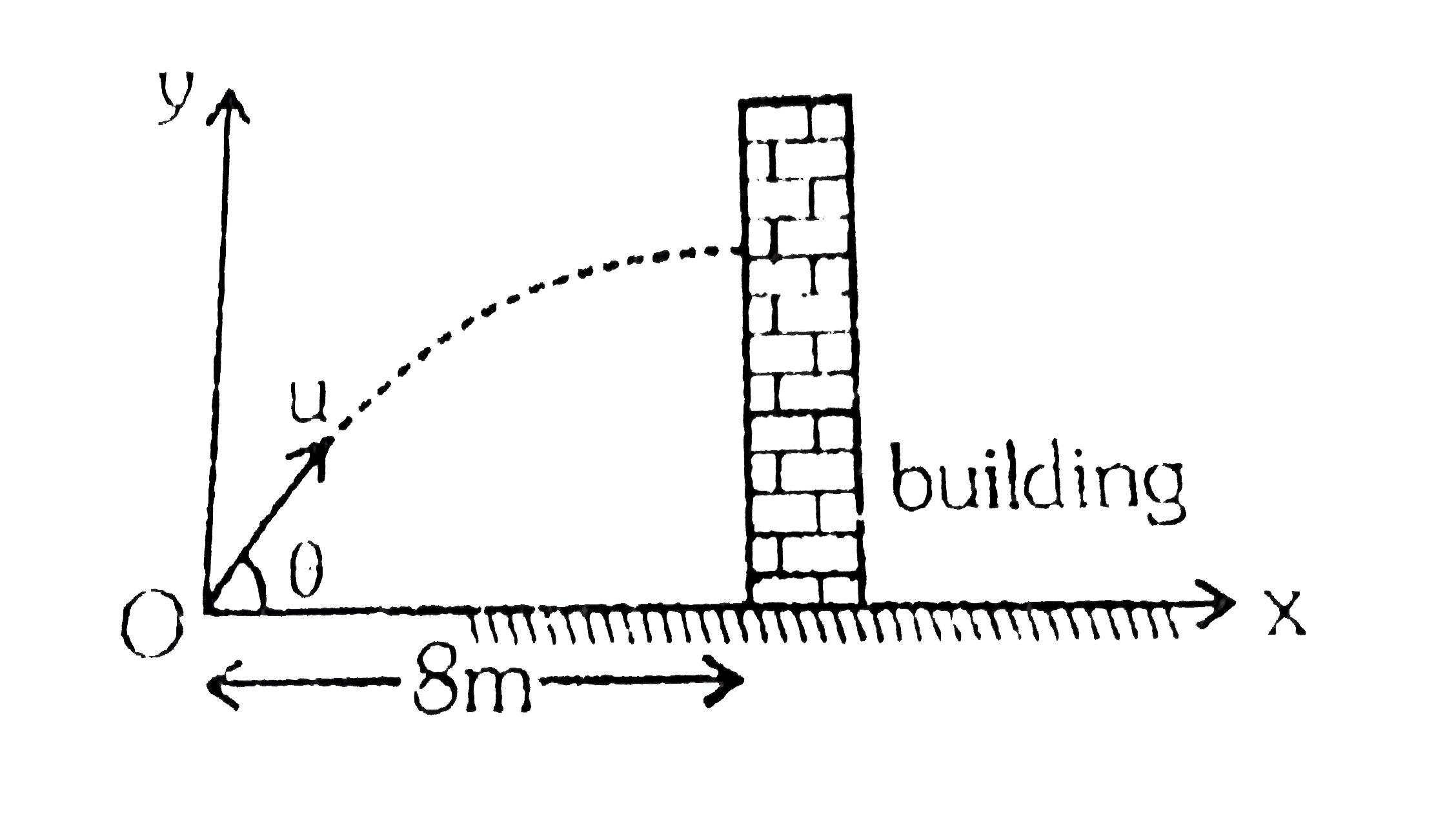A bird files due north at velocity 20 ms−1 for 15s it rests for 5s and then files due south at velocity 24ms−1 for 10s. For the whole trip find the average speed and magnitude of average velocity Solution in Gujrati

We have to project water achieving max.y for given x=8m
This can be solved by using equation of trajectory by putting x=8 m and maximizing y by varying θ.
By y=xtanθ−gx22u2cos2θ Here x=8m,u=20m/s
y=8tanθ−10×64(1+tan2θ)2×400
0.8tan2θ−8tanθ+(y+0.8)=0
for θ real b2−4×0.8(y+0.8)≥0
ymax=19.2m
Topper's Solved these Questions
- MOTION IN A PALNEBOOK - ALLEN CHAPTER - MOTION IN A PALNEEXERCISE - EXERCISE-02
37 Videos
- MOTION IN A PALNEBOOK - ALLEN CHAPTER - MOTION IN A PALNEEXERCISE - EXERCISE-03
6 Videos
- KINEMATICS-2DBOOK - ALLEN CHAPTER - KINEMATICS-2DEXERCISE - Exercise (O-2)
47 Videos
- NEWTON'S LAWS OF MOTION & FRICTIONBOOK - ALLEN CHAPTER - NEWTON'S LAWS OF MOTION & FRICTIONEXERCISE - EXERCISE (JA)
4 Videos
Similar Questions
The distance x of a particle moving in one dimensions, under the action of a constant force is related to time t by the equation, t=√x+3, where x is in metres and t in seconds. Find the displacement of the particle when its velocity is zero.
View SolutionA point traversed half the distance with a velocity v0. The remaining part of the distance was covered with velocity v1 for half the time, and with velocity v2 for the other half of the time. Find the mean velocity of the point averaged over the whole time of the motion.
View SolutionA particle is moving in xy-plane .At certain instant the components of its velocity and acceleration are as follows ux=3m/s,uy=4m/s,ax=2m/s2anday=1m/s2. The rate of change of speed at this moment is
View SolutionA piece of wire is bent in the shape of a parabola y=kx2 (y-axis vertical) with a bead of mass m on it. The bead can slide on the wire without friction. It stays at the lowest point of the parabola when the wire is at rest. The wire is now accelerated parallel to the x-axis with a constant acceleration a. The distance of the new equilibrium position of the bead, where the bead can stay at rest with respect to the wire, from the y-axis is:
View SolutionA body moves in the southern direction for 10 s at the speed of 10 ms^(-1) . It then starts moving in the eastern direction at the speed of 20 ms^(-1) for 10 s , The magnitude of the average velocity is …………………………, The averge speed is ……………………., The total displacement will be .....................,
View SolutionA ball is acted upon by the following velocities. (i) 3 ms^(-1) due East 9ii) 11 ms^(-1) due South and (iii) 5 sqrt 2 ms^(-1) due North-East. Find the magnitude and direction recultant velocity.
View SolutionA body is simultanceously given two velocities : one 12 ms^(-1) due East and other 5 ms^(-1) due North. Find the resultant velocity.
View SolutionIf the average velocity of N_(2) molecules is 0.3 ms^(-1) at 27^(@) C , then the velocity of 0.6 ms^(-1) will take place at
View SolutionA body is simultaneously given two velocities, one 10 ms^(-1) due east and other 20 ms^(-1) due north-west. Calculate the resultant velocity.
View SolutionFind the resultant of two velocities, on 30ms−1 due east and other 40ms−1 due north.
View SolutionA particle moves in the direction of east for 2s with velocity of 15ms−1. Then it moves towards north for 8s with a a velocity of 5ms−1. The average velocity of the particle is
View SolutionA particle is moving east wards with a velocity of 15 ms^(-1) . In a time of 10 s, the velocity changes to 15 ms^(-1) northwards. Average acceleration during this time is (in ms^(-2))
View SolutionA vehicle moves for 10 minutes at 20ms−1 due north and stops for five minutes. Then at continues due north at 40ms−1 for 20 minutes. Average velocity in the entire journey.
View SolutionA particle is moving east wards with a velocity of 5 ms−1 In 10 S , the velocity changes to 5 ms−1 north wards. The average acceleration in this time is
View SolutionA particle is moving east wards with a velocity of 5 ms^(-1) . In 10S the velocity changes to 5 ms^(-1) north wards. The average acceleration in this time is
View SolutionA soccer ball is travelling at a velocity 20 ms^-1 due south. At the end of its travel, it moves with a velocity 2 ms^-1 due south. If the change in the linear momentum of the ball is 18 kg ms^-1 due north, then the mass of the ball is
View Solution
